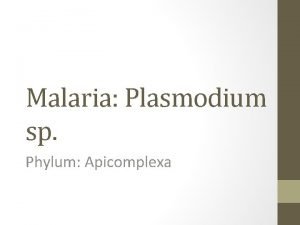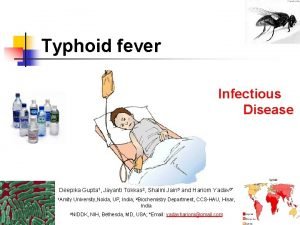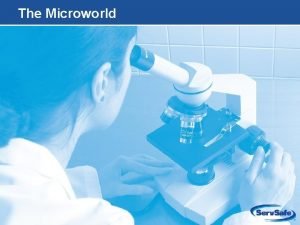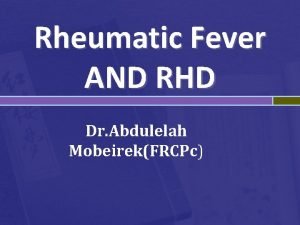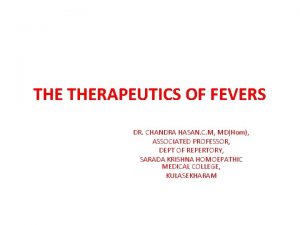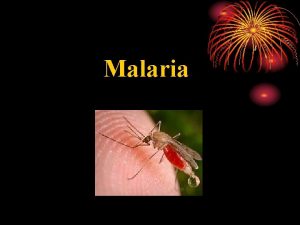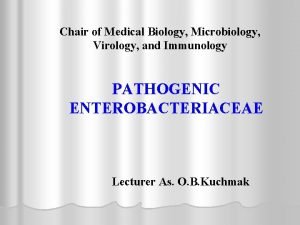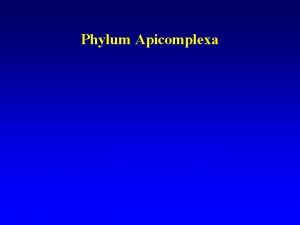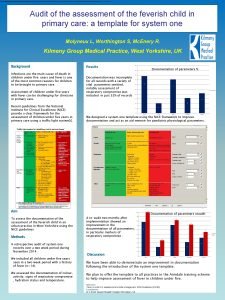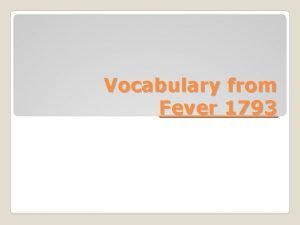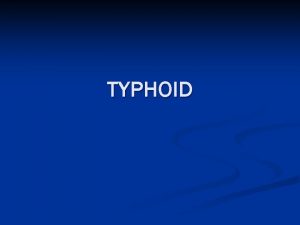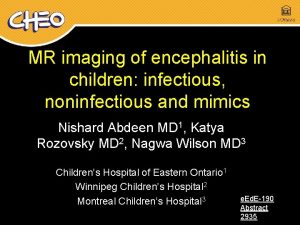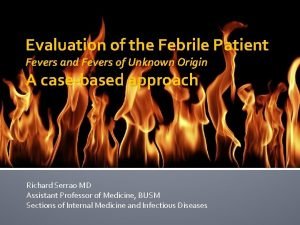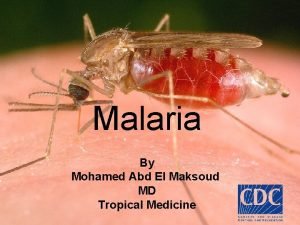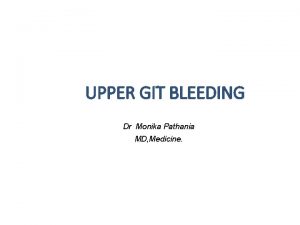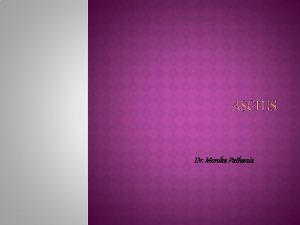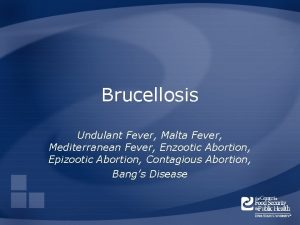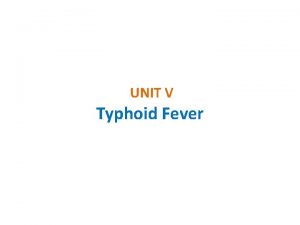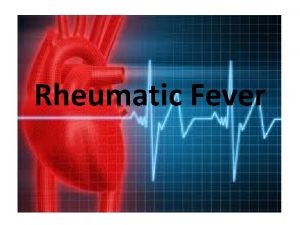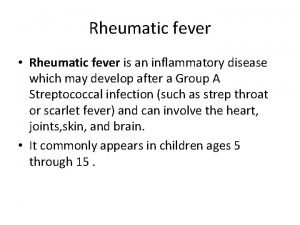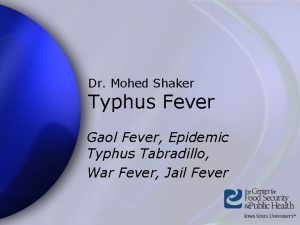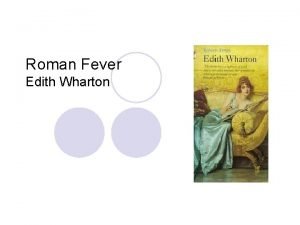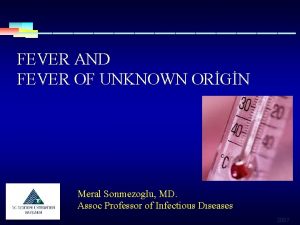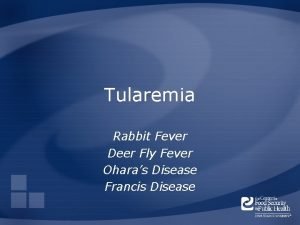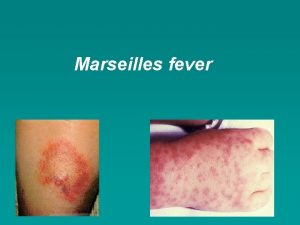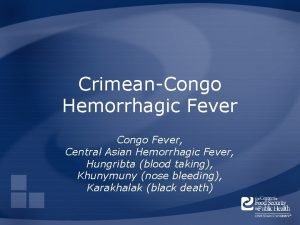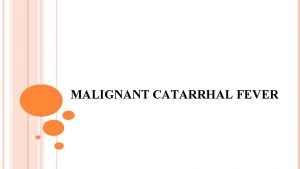FEVER DR MONIKA PATHANIA DEPTT OF MEDICINE OUTLINE



























- Slides: 27

FEVER DR MONIKA PATHANIA DEPTT OF MEDICINE

OUTLINE • • • THERMOREGULATION DEFINITION PATHOPHYSIOLOGY TYPE ASSOCIATED FEATURES

THERMOREGULATION • Body temperature is controlled by the hypothalamus. • Neurons in - preoptic anterior hypothalamus and posterior hypothalamus • two kinds of signals: 1. from peripheral nerves - from warmth/cold receptors in the skin 2. from the temperature of the blood bathing the region. • signals are integrated by thermoregulatory center of the hypothalamus to maintain normal temperature.

• maintain the core body temperature in the range of 36. 5– 37. 5°C (97. 7– 99. 5°F). • The formula to convert temperature recorded on Fahrenheit scale into Celsius scale: C/5 = F-32 / 9 • A normal body temperature is ordinarily maintained despite environmental variations because OF hypothalamic thermoregulatory SYSTEM.

• center balances the excess heat production derived from metabolic activity in muscle and the liver with heat dissipation from the skin and lungs.

• the mean oral temperature is 36. 8° ± 0. 4°C (98. 2° ± 0. 7°F), with low levels at 6 a. m. and higher levels at 4– 6 p. m. • The maximal normal oral temperature is 37. 2°C (98. 9°F) at 6 a. m. and 37. 7°C (99. 9°F) at 4 p. m.

DEFINITION • Fever is an elevation of body temperature that exceeds the normal daily variation i. e 0. 5°C (0. 9°F). and occurs in conjunction with an increase in the hypothalamic set point (e. g. , from 37°C to 39°C). • An a. m. temperature of >37. 2°C (>98. 9°F) or a p. m. temperature of >37. 7°C (>99. 9°F) would define a fever. • Rectal temperatures are generally 0. 4°C (0. 7°F) higher than oral readings.

PATHOPHYSIOLOGY • Fever is an elevation of body temperature that exceeds the normal daily variation and occurs in conjunction with an increase in the hypothalamic set point (e. g. , from 37°C to 39°C). • This shift of the set point from“normothermic” to febrile levels very much resembles the resetting of the home thermostat to a higher level in order to raise the ambient temperature in a room.

• Remittent Fever – temperatur remains above normal throughout the day and fluctuates more than 1 deg celsius in 24 hrs. E. g – infective endocarditis • Pel ebstein fever : specific fever assoc. With hodgkin’s lymphoma, being high for one week and low for the next week. . .

CAUSES • INFECTIOUS: MOST COMMON • NON INFECTIOUS: v. INFLAMMATORY v. JOINT AND CONNECTIVE TISSUE v. MALIGNANT TUMORS v. HEMATOLOGICAL DISEASE v. ALLERGIC REACTIONS

HISTORY • • CLUES: RESPIRATORY Symptoms: - URTI , LRTI URINARY SYMPTOMS: uti , cystitis Abdominal symptoms: - dysentry , abcess, acute abdomen Musculoskeletal symptoms: - RA, SLE, AS Cardiovascular symp. : - IE , Pericarditis Travel history Occupational history

ASSOCIATED FEATURES

• • • Macule-flat lesions defined by an area of changed color Papule-raised, solid lesion <5 mm Plaques-raised, solid lesion >5 mm Nodules-lesions >5 mm with more rounded configuration Vesicles-circumscribed, elevated lesions <5 mm containing fluid Bullae- circumscribed, elevated lesions >5 mm containing fluid Pustules- raised lesion containing purulent exudates Petechiae- purpuric lesions <3 mm Ecchymoses- purpuric lesion >3 mm

• • Centrally distributed maculopapular eruption: Rubeola Rubella Erythema infectiosum Exanthem subitum Primary HIV infection Infectious mononucleosis etc.

Measles

RUBELLA • spreads from hairline downwards, clearing as it spreads;

ERYTHEMA INFECCTIOSUM (FIFTH DISEASE) • human parvovirus B 19 • bright-red “slapped cheeks”

EXANTHEMATOUS DRUGINDUCED ERUPTION • Etiology- drugs(antibiotics, anticonvulsants, diuretics, etc. ) • Description- intensely pruritic, bright red macules and papules, symmetric on trunk and extremities; may become confluent • Groups affected- occurs 2 -3 days after exposure in previously sensitized individuals; otherwise, after 23 weeks (but can occur anytime, even shortly after drug is discontinued) • Clinical symptoms- variable findings: fever and eosinophilia


SYSTEMIC LUPUS ERYTHROMATOSUS • macular and papular erythema, often in sun exposed areas,

FIGURE SHOWING Septic emboli with haemorrhage and infarction due to acute Staphylococcus aureus endocardites.

HERPES ZOSTER

Eschar at the site of the mite bite in a patient with rickettsialpox.



MENINGOCOCCEMIA

THANKS
 Sandwich sentence writing
Sandwich sentence writing Black water fever is caused by
Black water fever is caused by My love is a fever longing still
My love is a fever longing still Typhoid fever
Typhoid fever Campylobacter fever
Campylobacter fever What is the theme of speak
What is the theme of speak Fever chart project management
Fever chart project management Black water fever
Black water fever Rhumatic fever criteria
Rhumatic fever criteria Diff between measles and chickenpox
Diff between measles and chickenpox Therapeutics of fever by h.c. allen
Therapeutics of fever by h.c. allen Toddler temperature
Toddler temperature Weil felix reaction
Weil felix reaction Thrombocytobenia
Thrombocytobenia Phase of dengue fever
Phase of dengue fever Laboratory diagnosis of typhoid fever
Laboratory diagnosis of typhoid fever Apicomplexa examples
Apicomplexa examples Symptoms of metal fume fever
Symptoms of metal fume fever Waterhouse friderichsen syndrome diagnosis
Waterhouse friderichsen syndrome diagnosis Fever 1793 setting
Fever 1793 setting Nice fever under 5
Nice fever under 5 Fever 1793 vocabulary
Fever 1793 vocabulary Fastigium fever
Fastigium fever Rasmussen syndrome
Rasmussen syndrome Fever type
Fever type Chocolate fever chapter 1
Chocolate fever chapter 1 Predinsolon
Predinsolon Black water fever caused by
Black water fever caused by

